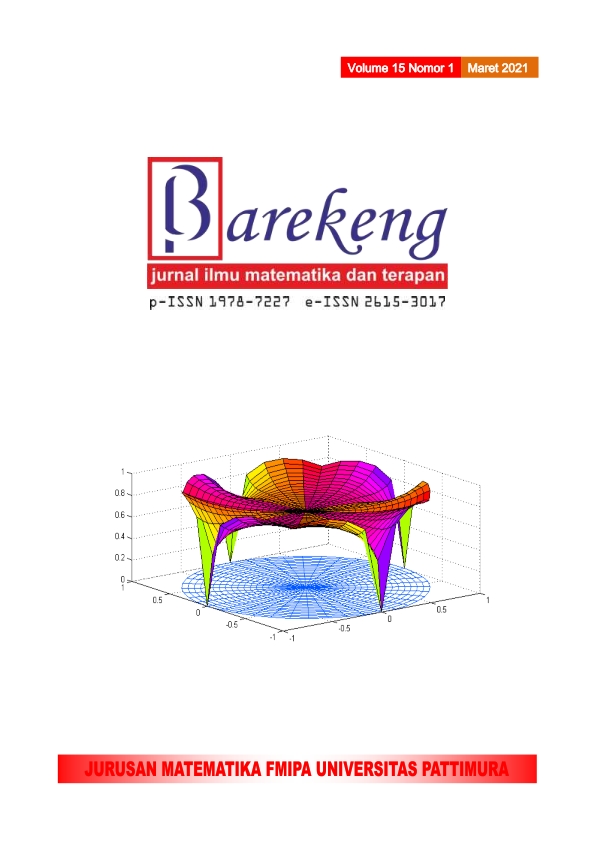PREDIKSI PELUANG KEMATIAN DAN KELAHIRAN MURNI PENDUDUK KABUPATEN MERAUKE MENGGUNAKAN METODE BIRTH AND DEATH PROCESS
Abstract
This study aims to estimate the probability of birth and death purely based on gender and population data of Merauke City. The chance of birth and death will be used to estimate the life table of the elderly in a population of the City of Merauke. The method used in this research is the birth and process method. The Birth and death process method which is a Poisson distribution is used to predict the chances of birth and death at time t. If the birth and death process fulfills the linearity requirements, then the processes are called the Yule-Furry process. This research discusses the stochastic process of pure birth-death with two sexes in the Yule-Furry Process. From the data on the population of Merauke district which is divided based on the sex of men and women using the pure birth and death model, the calculation results show that the probability value at the time interval 0 ≤ t <1 hour, at the initial time t = 0, the chance of individual birth at female sex is stationary at a value of 0.1762, while the chance of individual death for female sex is stationary at a value of 0.00154. The odds of birth and death in male individuals are stationary at a value of 0.305034 and 0, 059487.
Downloads
References
K. K. RI, Buletin Jendela Data dan Informasi Kesehatan. Jakarta: Bakti Husada., 2013.
H. d’Albis and F. Collard, “Age groups and the measure of population aging,†Demogr. Res., vol. 29, no. September, pp. 617–640, 2013, doi: 10.4054/demres.2013.29.23.
P. Penduduk and L. Usia, “Profil Penduduk Lanjut Usia 2009 25,†2009.
N. Sari, I. Mulyasari, and Dkk, Statistika Penduduk Lanjut Usia. Jakarta: Badan Pusat Statistik, 2020.
L. Németh and T. I. Missov, “Adequate life-expectancy reconstruction for adult human mortality data,†PLoS One, vol. 13, no. 6, pp. 1–8, 2018, doi: 10.1371/journal.pone.0198485.
R. I. Ibrahim, “Estimating a Complete Life Table Using the Heligman-Pollard Model , Six-Point Lagrangian Interpolation and King ’ S Osculatory Interpolation,†pp. 10–15, 2016.
M. RIYANA, H. SUMARNO, and B. SUHARJO, “Penentuan Metode Terbaik Untuk Pendugaan Life Table Penduduk Lanjut Usia Di Indonesia,†J. Math. Its Appl., vol. 17, no. 1, p. 61, 2018, doi: 10.29244/jmap.17.1.61-74.
D. J. Sharrow, S. J. Clark, M. A. Collinson, K. Kahn, and S. M. Tollman, “The Age Pattern of Increases in Mortality Affected by HIV: Bayesian Fit of the Heligman-Pollard Model to Data from the Agincourt HDSS Field Site in Rural Northeast South Africa.,†Demogr. Res., vol. 29, pp. 1039–1096, 2013, doi: 10.4054/DemRes.2013.29.39.
P. R. Parthasarathy and R. Sudhesh, “Exact transient solution of a state-dependent birth-death process,†J. Appl. Math. Stoch. Anal., vol. 2006, no. October, 2006, doi: 10.1155/JAMSA/2006/97073.
A. Mitrofanova and C. Science, “Backward Kolmogorov for Poisson Process,†2007.
Ngudiantoro, “Model Persamaan Diferensial Proses Kelahiran Yule-Furry dengan Dua Jenis Kelamin.†Jurnal Penelitian Sains, pp. 76-81., 2001, [Online]. Available: https://media.neliti.com/media/publications/168123-ID-model-persamaan-diferensial-proses-kelah.pdf.
E. Roflin, “Proses Stokastik Kelahiran-Kematian Murni,†Penelit. sains, vol. 2, pp. 38–51, 2000.
W. A. Thompson, H. M. Taylor, and S. Karlin, An Introduction to Stochastic Modeling., vol. 80, no. 390. 1985.
D. O. Cahoy and F. Polito, “Simulation and Estimation for the Fractional Yule Process,†Methodol. Comput. Appl. Probab., vol. 14, no. 2, pp. 383–403, 2012, doi: 10.1007/s11009-010-9207-6.
S. M. Ross, Introduction to Probability Models. 1993.
Authors who publish with this Journal agree to the following terms:
- Author retain copyright and grant the journal right of first publication with the work simultaneously licensed under a creative commons attribution license that allow others to share the work within an acknowledgement of the work’s authorship and initial publication of this journal.
- Authors are able to enter into separate, additional contractual arrangement for the non-exclusive distribution of the journal’s published version of the work (e.g. acknowledgement of its initial publication in this journal).
- Authors are permitted and encouraged to post their work online (e.g. in institutional repositories or on their websites) prior to and during the submission process, as it can lead to productive exchanges, as well as earlier and greater citation of published works.






1.gif)



